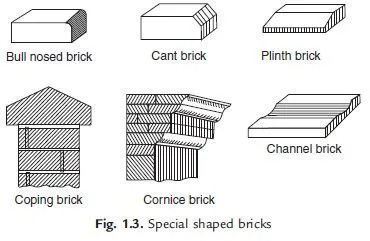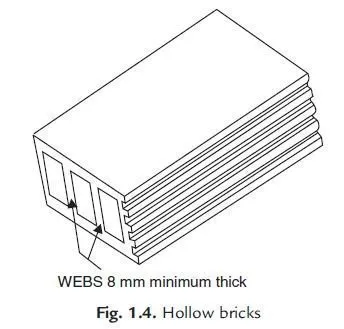Bricks may be broadly classified as:
(i) Building bricks
(ii) Paving bricks
(iii) Fire bricks
(iv) Special bricks.
(i) Building Bricks: These bricks are used for the construction of walls.
(ii) Paving Bricks: These are vitrified bricks and are used as pavers.
(iii) Fire Bricks: These bricks are specially made to withstand furnace temperature. Silica bricks belong to this category.
(iv) Special Bricks: These bricks are different from the commonly used building bricks with respect to their shape and the purpose for which they are made. Some of such bricks are listed below:
(a) Specially shaped bricks
(b) Facing bricks
(c) Perforated building bricks
(d) Burnt clay hollow bricks
(e) Sewer bricks
( f ) Acid resistant bricks.
(a) Specially Shaped Bricks: Bricks of special shapes are manufactured to meet the requirements of different situations. Some of them are shown in Fig.  (b) Facing Bricks: These bricks are used in the outer face of masonry. Once these bricks are provided, plastering is not required. The standard size of these bricks are 190 × 90 × 90 mm or 190 × 90 × 40 mm.
(b) Facing Bricks: These bricks are used in the outer face of masonry. Once these bricks are provided, plastering is not required. The standard size of these bricks are 190 × 90 × 90 mm or 190 × 90 × 40 mm.
(c) Perforated Building Bricks: These bricks are manufactured with area of perforation of 30 to 45 per cent. The area of each perforation should not exceed 500 mm2. The perforation should be uniformly distributed over the surface. They are manufactured in the size 190 × 190 × 90 mm and 290 × 90 × 90 mm.
(d) Burnt Clay Hollow Bricks: Figure shows a burnt clay hollow brick. They are light in weight. They are used for the construction of partition walls. They provide good thermal insulation to buildings. They are manufactured in the sizes 190 × 190 × 90 mm, 290 × 90 × 90 mm and 290 × 140 × 90 mm. The thickness of any shell should not be less than 11 mm and that of any web not less than 8 mm. 
(e) Sewer Bricks: These bricks are used for the construction of sewage lines. They are manufactured from surface clay, fire clay shale or with the combination of these. They are manufactured in the sizes 190 × 90 × 90 mm and 190 × 90 × 40 mm. The average strength of these bricks should be a minimum of 17.5 N/mm2 . The water absorption should not be more than 10 per cent.
( f ) Acid Resistant Bricks: These bricks are used for floorings likely to be subjected to acid attacks, lining of chambers in chemical plants, lining of sewers carrying industrial wastes etc. These bricks are made of clay or shale of suitable composition with low lime and iron content, flint or sand and vitrified at high temperature in a ceramic kiln.
this is good website and also a very benifitial website. i like this very much. and do respect to its admin